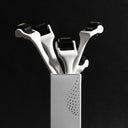Silky, smooth hair is a dream for many individuals, but achieving that coveted glossy texture can sometimes be a challenge, especially if you're dealing with dryness, frizz, or damage. Fortunately, hairdressers have a wide array of products and treatments at their disposal to help transform even the most unruly locks into a sleek, silky masterpiece.
Table of content
What do hairdressers put in your hair to make it silky?
Hairdressers employ a variety of techniques and products to enhance the silkiness and smoothness of hair. Here are some of the most common treatments and ingredients they use to achieve that desired silky texture:
- Smoothing Serums and Oils: Hairdressers often apply smoothing serums or hair oils to tame frizz and add a sleek, silky finish. These products typically contain nourishing ingredients like argan oil, moroccan oil, or silicones that help smooth the hair cuticle and lock in moisture.
- Keratin Treatments: Keratin treatments are a popular salon service that can significantly improve hair's smoothness and manageability. These treatments infuse the hair with keratin, a protein that helps strengthen and seal the cuticle, resulting in a silky, frizz-free finish that can last for several months.
- Glossing Treatments: Glossing treatments are semi-permanent salon services that coat the hair with a protective gloss or sealant. These treatments not only add incredible shine and smoothness but also help to seal the cuticle, reducing frizz and promoting a silky texture.
- Deep Conditioning Masks: Intensive deep conditioning masks can help nourish and hydrate dry, damaged hair, making it more manageable and silky. Hairdressers often use masks containing ingredients like shea butter, coconut oil, or plant-based proteins to deeply condition and smooth the hair.
- Leave-In Conditioners: Leave-in conditioners are a staple in many salons, as they help to detangle, smooth, and add silkiness to the hair. These lightweight products often contain ingredients like silicones, oils, and humectants to help tame frizz and enhance manageability.
It's important to note that the specific products and treatments used may vary depending on the individual's hair type, texture, and condition, as well as the desired level of smoothness and silkiness.
As your leading source for hair health information over the past 4 years, we never compromise on accuracy. When it comes to your health, you deserve information you can truly rely on - and earning your trust is our top priority.
Here's how Scandinavian Biolabs ensures every piece of content meets the highest standards of accuracy and integrity:
- Credentialed Experts: Our reviewers are actively practicing doctors and medical researchers
- Stringent Reviews: Content undergoes rigorous editing by subject specialists and review by a practicing doctor.
- Evidence-Based: We rely on well-established research from trusted scientific sources like peer-reviewed journals and health authorities.
- Full Transparency: Our editorial standards, writer credentials, reviewer credentials, correction process, and funding are all publicly documented.
- Independent Voice: While we do promote products, we operate in a vacuum to business operations. Our main goal is just an unwavering commitment to providing medically-sound guidance.
You can count on Scandinavian Biolabs to consistently deliver the trustworthy health information you deserve. Read our Editorial Standards.
Understanding Silky Hair
To better appreciate the techniques and products used by hairdressers to achieve silky hair, it's helpful to understand the science behind a smooth, silky texture:
The Hair Cuticle
The outermost layer of the hair strand is called the cuticle, and its condition plays a significant role in determining the hair's overall smoothness and silkiness. When the cuticle is smooth and flat, it allows light to reflect evenly, creating a sleek, shiny appearance. However, when the cuticle is raised or damaged, it can cause light to scatter unevenly, resulting in a rough, dull, and frizzy texture.
Moisture and Nourishment
Dry, dehydrated hair is more prone to frizz, breakage, and an overall rough texture. By infusing the hair with moisture and nourishing ingredients like oils and butters, hairdressers can help smooth the cuticle and improve the hair's overall silkiness and manageability.
Protein and Strength
Damaged or weakened hair can often appear dull and rough due to a compromised internal structure. Treatments like keratin or protein-based masks can help strengthen the hair from the inside out, improving its elasticity and smoothness.
Tips for Maintaining Silky Hair
While salon treatments can provide an instant boost of silkiness, maintaining that smooth, sleek texture requires ongoing care and attention. Here are some tips to help keep your hair silky and smooth between salon visits:
- Use Sulfate-Free Shampoos: Sulfates are harsh cleansing agents that can strip the hair of its natural oils, leading to dryness and frizz. Opt for sulfate-free shampoos and conditioners to gently cleanse while preserving moisture.
- Protect from Heat: Excessive heat styling can cause the cuticle to become raised and damaged, resulting in a rough, dry texture. Use heat-protectant products and minimize the use of hot tools when possible.
- Embrace Satin or Silk: Swap out cotton pillowcases for satin or silk alternatives, which can help reduce friction and prevent hair from becoming tangled and frizzy overnight.
- Deep Condition Regularly: Incorporate weekly deep conditioning treatments into your routine to help nourish and hydrate your hair, promoting a smoother, silkier texture.
- Trim Split Ends: Split ends can travel up the hair shaft, causing strands to appear dry and frayed. Regular trims can help remove damaged ends and maintain a smooth, silky appearance.
By combining professional salon treatments with a gentle, nourishing at-home routine, you can achieve and maintain the silky, smooth hair of your dreams. Remember, consistency and patience are key when it comes to transforming and preserving your hair's texture.
Is damaged hair leaving you stressed?
Scandinavian Biolabs Hair Strength Shampoo can help! This gentle, nature-inspired formula is designed to help repair your damaged hair:
- Revitalize dry, brittle hair.
- Reduce frizz and split ends.
- Support stronger and healthier hair growth.
- Cleanse without stripping natural oils.
Experience the difference of healthy, vibrant hair.
Read more:






